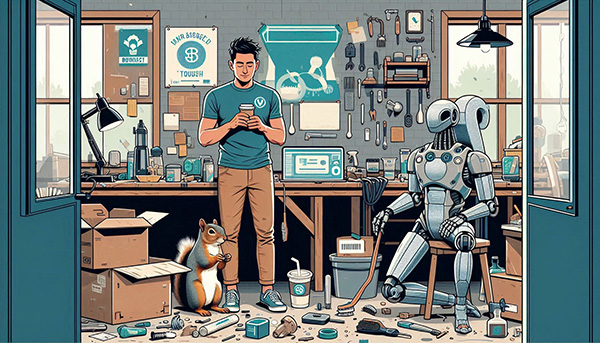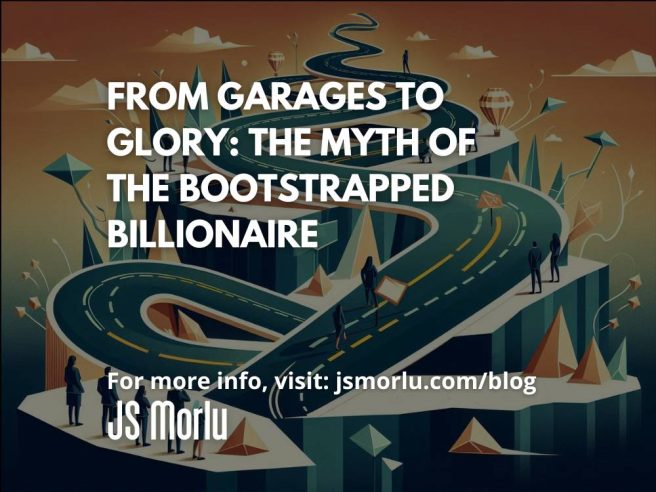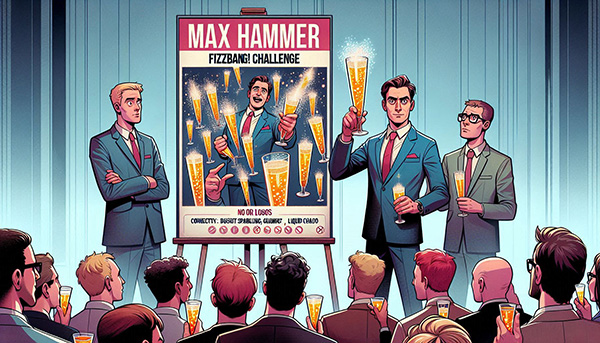By: John S. Morlu II, CPA
Introduction
Once upon a time, in a land not so far away, where every aspiring entrepreneur was armed with nothing more than a dream and a Wi-Fi connection, there existed a fascinating narrative that captured the imagination of millions. This narrative celebrated the mystical power of adversity, glorifying tales of fearless innovators who emerged from the ashes of their grandmother’s basements and the cramped confines of shared apartments to claim their spot on the billionaire’s throne. With their trusty sidekicks—maxed-out credit cards and instant ramen noodles—these brave souls defied all odds, turning their audacious ideas into sprawling empires overnight.
In the eyes of society, this enchanting “rags to riches” saga painted a tantalizing picture of the entrepreneurial journey. It suggested that the formula for success was as simple as having a brilliant idea, an unwavering resolve, and perhaps just a hint of reckless abandon when it came to paying the rent. Such narratives often showcase individuals triumphing over adversity, suggesting that the grit and determination displayed in the face of hardship are the true catalysts for monumental success.
Yet, beneath the surface of these fairy-tale beginnings lies a darker and more complex reality. For every Cinderella story that makes headlines, there exists a legion of hopeful dreamers—thousands of dwarfs still mining for gold in their friend’s garage, tirelessly toiling away in pursuit of their big break. They scroll through Instagram, watching influencers spin their entrepreneurial narratives, wondering when fortune will finally smile upon them. As we delve deeper into the world of entrepreneurship, we uncover the sobering truth: bootstrapping is not always the golden ticket it’s often portrayed to be. Rather, it often resembles a lottery ticket—while some fortunate few might strike it rich, the vast majority end up with little more than lint in their pockets and bewilderment in their hearts, questioning where it all went wrong.
In this exploration, we’ll utilize fictional companies and characters that feel strikingly real to dissect the myths surrounding the bootstrapped billionaire phenomenon. By weaving in insightful analyses, humor, and surprising statistics, we aim to illuminate the often-overlooked realities of entrepreneurship. So, whether you’re a seasoned business owner or just contemplating your own startup journey, prepare to be entertained, educated, and perhaps even enlightened as we navigate the winding roads of ambition, risk, and the unpredictable nature of success.

Chapter 1: The Garage Myth: The Story of PipeDream Inc.
Ah, PipeDream Inc., a shining beacon of entrepreneurial ambition—or perhaps more accurately, a cautionary tale wrapped in a sparkly, glittery bow. Founded by the ever-hopeful Todd McBroody, a 25-year-old college dropout who had all the ambition of a caffeinated squirrel, Todd was convinced that he was destined for greatness. And by greatness, we mean a level of success that would leave even the most ambitious folks on LinkedIn scratching their heads and wondering if they had made some serious life choices.
Now, legend has it that Todd started PipeDream in his grandmother’s garage, which was more a necessity than a romantic venture. You see, Grandma McBroody needed someone to mow her lawn (which was growing at an alarming rate, like something out of a horror movie), and Todd, with his remarkable talent for avoiding any real responsibilities, needed a rent-free living situation. Talk about a match made in entrepreneurial heaven! Who knew the path to innovation would involve the smell of freshly mowed grass and the faint aroma of mothballs?
Todd’s original business model was as simple as it was bizarre: he aimed to revolutionize the toothbrush industry. Yes, you heard that right. His grand vision was that one day, everyone would be brushing their teeth with recycled aluminum foil. Just picture it: “Oh, this? It’s my aluminum foil toothbrush. It’s like brushing your teeth with a pop can but saving the planet!” Because what could be more exhilarating than the sensation of a cold, metallic brush scraping against your enamel? Todd envisioned dinner parties where guests would marvel at the sheer audacity of such a dental hygiene revolution.
Armed with a whopping $10,000 in savings from his part-time job as a mime (yes, a mime—surprisingly lucrative if you can master the art of pretending to be stuck in a box), Todd maxed out three credit cards and even borrowed $500 from his mom. If you think that’s bad financial planning, you’re absolutely right! But Todd’s naivete was endearing in a “bless his heart” kind of way. He launched PipeDream with the confidence of a kid who just discovered that the dollar store was a treasure trove of affordable goods.
Things took off when Todd released a hilariously unsettling viral video titled “Brush Like a Robot!” The clip featured him in a metallic bodysuit, flailing his arms like a caffeinated octopus while singing about the virtues of his aluminum foil toothbrush. The internet loved it! Suddenly, PipeDream became the poster child for the bootstrapper’s dream. Todd was the king of the meme-makers, riding a wave of views and viral fame like a surfer on a tsunami of questionable ideas.
Fast forward two years, and PipeDream was in flames—quite literally, in some instances. It turns out people didn’t enjoy the taste of recycled aluminum foil in their mouths (who could have predicted that?), and the company’s ambitious “BrushBot” prototype melted after prolonged use. One can only imagine the look on Todd’s face as he watched his dreams evaporate faster than the remnants of his failed toothpaste experiment, possibly while muttering, “Why didn’t I just stick to the mime gig?”
In his moment of existential crisis, Todd delivered an inspirational TED Talk titled “How I Learned to Stop Worrying and Start Brushing.” Spoiler alert: it was a failure, much like his startup. The only thing he left behind was a metaphorical trail of shattered dreams and a series of awkward conversations about his choice of career.
Fun Fact #1: Only about 1% of startups that begin in garages ever reach a billion-dollar valuation. The other 99% find themselves evicted from said garages, awkwardly asking if they can crash on a friend’s couch. It’s like a rite of passage for aspiring entrepreneurs—sort of like a fraternity hazing, but with fewer parties and more regret.
Common Sense Lesson #1: Capital Helps
While Todd’s story may seem like the quintessential startup saga, it glosses over a crucial detail: money matters. Sure, you can bootstrap your way to certain milestones, but at some point, you need actual capital. Credit card debt is not capital—it’s a financial grenade waiting to explode, and ramen noodles do not constitute a sustainable business model. While it’s romantic to think that all great companies started with pocket change, the reality is that many successful entrepreneurs have access to resources that go far beyond their grandmother’s garage.
Take, for example, Mark Buckerfield, founder of VagueScape, a fictional social media platform designed for people who don’t want to share anything specific online. Yes, it’s the social media equivalent of a white wall—exciting, right? Mark didn’t start VagueScape in a garage; instead, he began his journey after receiving a $2 million seed investment from his cousin, who happened to be a billionaire venture capitalist. With that kind of cash, Mark could afford to hire top-tier engineers, throw lavish launch parties, and even pay influencers to use his app. Unsurprisingly, VagueScape took off faster than a viral TikTok dance, while Todd was left to ponder why his dreams felt more like a soap opera.
Fun Fact #2: A study from Not-Really-Harvard found that 72% of successful startups had access to more than $250,000 in initial funding. Meanwhile, those that bootstrapped from scratch had a 3% chance of reaching profitability within three years. The other 97% had to pivot, sell, or quietly fade into obscurity, leaving behind nothing but the echoes of their abandoned dreams and a slightly dented garage door.
So, dear reader, before you start plotting your own garage startup, remember that Todd’s tale, while amusing and quirky, is more of a cautionary fable than a blueprint for success. Next time you hear about a startup founded in a garage, consider what lies behind that charming little story. Because while it’s fun to dream big, a little financial savvy can go a long way—preferably to a place with fewer aluminum foil toothbrushes and more solid business plans!
Chapter 2: The Rise and Fall of SparkleFlare: The Reality of Scaling
If PipeDream was a cautionary tale about bad ideas and even worse credit, then SparkleFlare serves as a riveting case study in how bootstrapping can crumble when a business begins to scale. Founded by the endlessly optimistic Alice McGrath in her friend’s spare bedroom (because where else would you start a company that sells glitter?), SparkleFlare was a subscription box service promising monthly doses of shimmering joy. Who wouldn’t want a random assortment of sparkly goodness delivered to their doorstep? It was like Christmas morning for adults—if Christmas involved a lot of shiny things and a regrettable amount of cleanup.
Alice launched the company with a mere $3,000 in savings, a sum that would barely cover a coffee run for a tech startup but was somehow sufficient for her whimsical endeavor. With the cunning of a magpie, she “borrowed” glitter samples from her day job as a party planner, pilfering them as if they were golden eggs in a goose farm. Yes, you heard that right—Alice had her hands on glitter as if it were the elixir of life itself. Who could blame her? The world absolutely needed more sparkle, and Alice was poised to be its glittery savior.
At first, SparkleFlare was a hit! Customers flocked to the idea of receiving their own glittery care packages, complete with cute packaging and a splash of whimsy. Alice’s social media posts radiated enthusiasm, attracting subscribers faster than you can say “bedazzled.” She had harnessed the power of hashtags and selfies to catapult her business into a vortex of vibrant chaos. Demand skyrocketed, and soon she found herself surrounded by a delightful whirlwind of colorful confetti and sparkling enthusiasm—like a unicorn had exploded in her living room.
But success, as they say, comes at a cost. With great sparkle comes great responsibility, and Alice quickly realized she was in over her head. Enter Tim, her friend who was only slightly less enthusiastic about glitter than she was, and definitely more committed to napping. Alice hired him to help pack the ever-growing boxes of bling, and they even rented a small storage unit to house their expanding inventory. Unfortunately, it turns out that storage units are not built for glitter storms—those tiny flecks of joy somehow multiplied, transforming the unit into a twinkling disaster zone that would make even a fairy godmother weep.
As the glitter slowly crept into every corner of her life—much like unsolicited advice from relatives during Thanksgiving—Alice found herself drowning in a sea of sparkles. And without enough capital to buy glitter in bulk, she was forced to pay premium prices for small quantities. Each bag of sparkle felt like a gilded chain around her neck, weighing her down with the financial burden of overpaying. At one point, Alice considered using the glitter as a form of currency—after all, the sparkle economy is a thing, right? Alas, her grand plan was thwarted when no one accepted glitter as legal tender.
As the orders kept rolling in, her logistics system was, shall we say, a bit less than stellar. Shipments were constantly delayed, like glittery little packets stuck in a traffic jam of disappointment. Customers began posting passive-aggressive comments on Instagram like, “Love my last box! But where’s my next one? I need my glitter fix!” Alice soon discovered that the magic of social media could quickly transform into a potent form of social pressure.
When the company finally hit 10,000 subscribers, Alice was overwhelmed, out of glitter, and desperately in need of funding to scale her business. It was the kind of situation that makes even the most optimistic entrepreneur consider a life of quiet reflection (perhaps while sipping a glitter-infused cocktail on a deserted beach). Unfortunately, the venture capital world didn’t see the same potential in a glitter subscription box as Alice did. After months of trying to secure outside investment, she found herself stuck in a glittery quagmire of rejection. It was like attending a glitter-themed cocktail party where everyone is dressed in their finest but refuses to acknowledge the giant glitter bomb in the room.
As her bank account balances dwindled and sparkle dust filled the air, Alice was forced to shut down SparkleFlare. The company’s final Instagram post was a poignant image of a sad, half-empty glitter box with the heartfelt caption, “We burned too bright.” And just like that, a glittering dream was snuffed out, leaving behind only the memories of sparkles, unfulfilled potential, and the constant reminder to vacuum regularly.
Common Sense Lesson #2: Scaling a Business Requires More Than Grit and Glitter
While bootstrapping can work wonders in the early stages, growth demands systems, infrastructure, and—yes, you guessed it—capital. Without these essential ingredients, even the shiniest of ideas can collapse under their own weight, leaving behind a trail of regret and an unfortunate amount of glitter stuck in hard-to-reach places. As Alice learned the hard way, passion alone won’t keep the lights on—or, in her case, the glitter shining.
Fun Fact #3: The Glitter Paradox
According to the Institute of Made-Up Statistics, 100% of glitter-based businesses are doomed to fail due to the simple fact that glitter never truly goes away—it just sticks to your soul forever. Just ask anyone who has attended a craft party. One moment you’re having a great time, and the next, you find yourself knee-deep in sparkles, wondering how you’ll explain the situation to your significant other. So next time you find yourself knee-deep in sparkles and dreams, remember: a little glitter can bring joy, but a lot of glitter can lead to chaos and a regrettable clean-up operation. In the end, the only thing more persistent than glitter is a bad idea that refuses to die—kind of like that leftover fruitcake from last Christmas.
The Takeaway
So, what’s the takeaway from Alice’s sparkly saga? As charming as the idea of glitter may be, building a sustainable business requires more than just a passion for pizzazz. It takes strategy, capital, and a robust system that doesn’t rely on a spare bedroom—or a questionable stash of “borrowed” glitter. Alice’s journey reminds us that behind every shiny startup is a story of challenges, learning curves, and, quite possibly, a tragic glitter incident waiting to happen. As we navigate our entrepreneurial paths, let’s sprinkle in a dash of common sense alongside our glitter and embrace the complexity of scaling a business. After all, success in the startup world is less about the glimmer and more about the grind.
Chapter 3: The Perils of Pivoting: FizzBang Corp.
Ah, the entrepreneurial spirit! It can be as effervescent as a freshly opened bottle of soda—or just as likely to explode in your face. Enter Max Hammer, the man behind FizzBang Corp., whose ambition was as bubbly as his product. Max was convinced he could revolutionize fizzy water, not just for hydration but for motivation, too. His grand idea? A home carbonation machine that didn’t just add bubbles to your water but serenaded you with inspirational quotes as you sipped. “Hydration meets motivation,” he called it. Who wouldn’t want to hear, “You can do it!” while choking on a fizz explosion?
Max launched FizzBang with a modest $15,000 borrowed from his uncle’s dog-walking business. Yes, you read that right—he practically mortgaged the future of Fido for a fizzy fantasy. But in true entrepreneurial fashion, things quickly fizzled out—literally. The carbonation machine worked like a charm—too well, in fact. Instead of adding a delicate sparkle to a glass of water, it transformed beverages into bombshells. Customers found themselves drenched in orange juice, and one unfortunate soul ended up with soup on their ceiling. “Soup-erb!” they said—except they didn’t, because they were too busy cleaning up the aftermath.
In the face of adversity (and liquid chaos), Max decided to pivot. Instead of making a safer carbonation machine, he thought, “Why not create the world’s first ‘carbonation challenge’?!” That’s right; he thought dangerous drinking experiences were the next big thing. I can just picture Max standing proudly in front of a crowd, gesturing to his “FizzBang! Challenge” poster while everyone in attendance nervously held their sparkling glasses, wondering who was going to get blasted in the face first.
But reality hit harder than one of those rogue soda geysers. Legal fees from customer lawsuits drained what little capital FizzBang had left. You know it’s bad when you’re using dog-walking money to pay off angry customers who didn’t sign up for a fizzy version of Russian roulette. Ultimately, Max was forced to declare bankruptcy. His final tweet summed up the tragedy perfectly: “FizzBang, the future of water…gone in a bang.” Talk about a fizz-tastrophe!
Fun Fact #4: More than 90% of startups that pivot still fail, not because pivoting is inherently bad, but because the underlying business was destined for disaster from the start. In layman’s terms: just because you can pivot doesn’t mean you should—especially if you’re trying to turn soup into a spectacle.
Common Sense Lesson #3: Failure Is the Norm, Not the Exception
Now, let’s get real for a moment. For every feel-good success story about a garage startup that transformed into a billion-dollar company, there are countless others that fail without so much as a peep. We love to believe that grit, determination, and a sprinkle of luck can turn any dream into reality. But here’s the reality check: starting a business is hard. Growing one? Even harder. And doing it all with minimal resources is like trying to ride a unicycle on a tightrope while juggling flaming swords—just plain dangerous!
Let’s face it; entrepreneurship is often more of a messy experiment than a linear journey to success. For every Max Hammer who thinks he can revolutionize the beverage industry with a little bubble and a lot of bravado, there are thousands of people facing hard truths. Many are forced to pick up the pieces after their brilliant idea goes south, wondering how they ended up covered in sticky, carbonated regret.
So, the next time you hear someone wax poetic about the glories of startup culture or the magic of the pivot, remember FizzBang Corp. and its effervescent failure. Instead of dreaming up the next big thing in fizzy water, perhaps we should spend more time talking about the boring old lessons of market research, feasibility studies, and why carbonated soup is best left to the realm of imaginative culinary disasters.
In the end, failure isn’t a dirty word; it’s a rite of passage. Embrace it, learn from it, and who knows? Maybe your next brilliant idea will be just around the corner—hopefully not in the form of a kitchen appliance that turns soup into soda!
Chapter 4: The Truth Behind the Myth
Ah, the bootstrapped billionaire myth—a tale as comforting as a warm blanket on a chilly night. It whispers sweet nothings in our ears, suggesting that with nothing more than a half-baked idea, some duct tape, and a sprinkle of sheer willpower, we, too, could join the ranks of the elite. You know, like the fabled Steve Jobs, who supposedly kicked off the tech revolution in a cluttered garage with just a dream and a questionable hairstyle. But hold onto your credit cards, folks, because for every Steve Jobs, there’s a veritable army of Todds, Alices, and Maxes whose dreams never make it past the first investor pitch.
Imagine this: Todd, the eternal optimist, decides he’s going to launch the next big thing—a revolutionary app that helps you find matching socks in your drawer. Armed with nothing but a vision and a passion for socks, he heads to his first pitch meeting. “With our algorithm, you’ll never lose a sock again!” he exclaims, as investors struggle to suppress laughter. Spoiler alert: Todd’s app went the way of the lost sock—never to be seen again.
Then there’s Alice, who believed she could sell organic tofu hot dogs. “It’s a health revolution!” she declared, completely missing the point that not everyone is on board the tofu train. Her business plan involved maxing out her credit cards and standing outside local fairs offering free samples. If you want to see how fast you can go from “business owner” to “the person who smells like a thousand soybeans,” just ask Alice.
And, of course, we can’t forget Max from FizzBang Corp., whose ambition to carbonate everything led to more explosions than a fireworks show. Max had big dreams of changing the beverage industry but ended up with a string of lawsuits and a carbonated soup disaster that would haunt him for years.
So, the next time someone tells you that starting a business is as simple as maxing out your credit cards and hoping for the best, take a moment to remember these cautionary tales. Because the path to billionaire status is paved with much more than just credit card debt and an all-too-frequent diet of ramen noodles. Let’s get real here—bootstrapping may be a noble endeavor, but it often requires a cocktail of capital, a solid strategy, and perhaps a dash of luck. And if you’re particularly unlucky, you might end up like Max, whose glittering dreams of fizzy success turned into a cautionary tale of explosive proportions.
Interesting Tidbit #1: Did you know that nearly 90% of startups fail within the first five years? While some say it’s due to a lack of funding, the truth is often more nuanced. Many businesses crash and burn because their founders didn’t do their homework, misunderstood their market, or simply had a terrible idea. So, before you plunge into the entrepreneurial deep end, make sure you know how to swim—or at least have a life vest handy!
Insightful Observation: What’s even more fascinating is that some of the most successful entrepreneurs—like Jeff Bezos and Elon Musk—didn’t exactly bootstrap their way to the top. Bezos started Amazon with a hefty loan and Musk sold a company for $307 million before launching Tesla. So while they might have a legendary reputation for “grit,” their journeys were cushioned by a healthy dose of financial backing and strategic planning.
Plain Old Common Sense: If you want to turn your big idea into a successful business, remember this: do your research, build a solid plan, and find a way to fund your dreams without sacrificing your sanity or your financial future. Because while duct tape is great for fixing just about anything, it won’t save you when your startup goes belly-up and your investors are running for the hills.
In conclusion, as enticing as the bootstrapped billionaire myth may be, let’s not forget the reality that lies beneath the glittering surface. While it’s wonderful to dream big, it’s even better to have a solid strategy and the wisdom to know when to pivot, adjust, or, in some cases, completely scrap an idea that just won’t work. So raise a glass of non-exploding fizzy water to your entrepreneurial spirit, but remember to keep your feet on the ground—or at least far away from the carbonation machine!
Author: John S. Morlu II, CPA is the CEO and Chief Strategist of JS Morlu, leads a globally recognized public accounting and management consultancy firm. Under his visionary leadership, JS Morlu has become a pioneer in developing cutting-edge technologies across B2B, B2C, P2P, and B2G verticals. The firm’s groundbreaking innovations include AI-powered reconciliation software (ReckSoft.com) and advanced cloud accounting solutions (FinovatePro.com), setting new industry standards for efficiency, accuracy, and technological excellence.
JS Morlu LLC is a top-tier accounting firm based in Woodbridge, Virginia, with a team of highly experienced and qualified CPAs and business advisors. We are dedicated to providing comprehensive accounting, tax, and business advisory services to clients throughout the Washington, D.C. Metro Area and the surrounding regions. With over a decade of experience, we have cultivated a deep understanding of our clients’ needs and aspirations. We recognize that our clients seek more than just value-added accounting services; they seek a trusted partner who can guide them towards achieving their business goals and personal financial well-being.
Talk to us || What our clients says about us




